Navigation
Scientists Identify Microbes Responsible for Consuming Natural Gas in Deepwater Horizon Spill
- bacteria
- Deepwater Horizon
- ethane
- Gulf of Mexico
- hydrocarbons
- microbes
- natural gas
- oil
- oil spills
- PNAS
- Proceedings of the National Academy of Sciences
- propane
- U.S. National Science Foundation (NSF)
- UCSB
- University of California at Santa Barbara
- Energy
- Global Climate Change
- Pollution
- Toxic Chemicals
- Waste Management
- Water
In the results of a new study, scientists explain how they used DNA to identify microbes present in the Gulf of Mexico following the Deepwater Horizon oil spill and the particular microbes responsible for consuming natural gas immediately after the spill.
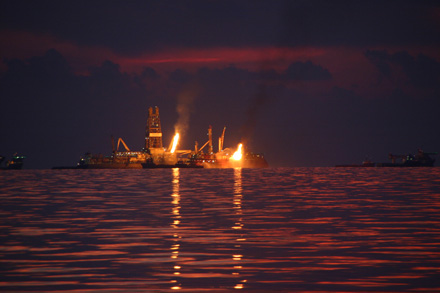 |
| Flares of captured gas (left) and oil (right) at the Deepwater Horizon spill site in June 2010. Photograph by David Valentine |
In the results of a new study, scientists explain how they used DNA to identify microbes present in the Gulf of Mexico following the Deepwater Horizon oil spill and the particular microbes responsible for consuming natural gas immediately after the spill.
The researchers found that water temperature played a key role in the way bacteria reacted to the spill.
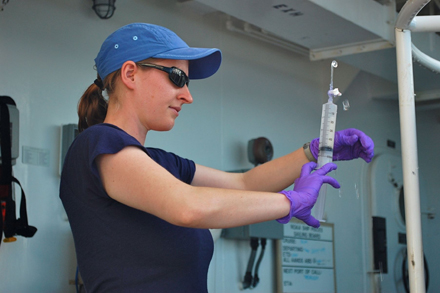 |
| Scientist Molly Redmond with a sample taken as part of the Gulf oil spill microbes study. Photograph by David Valentine |
David Valentine and Molly Redmond, geochemists at the University of California at Santa Barbara (UCSB) conducted the study. The National Science Foundation (NSF) and the Department of Energy supported it. Proceedings of the National Academy of Sciences (PNAS) published their results in this week's journal.
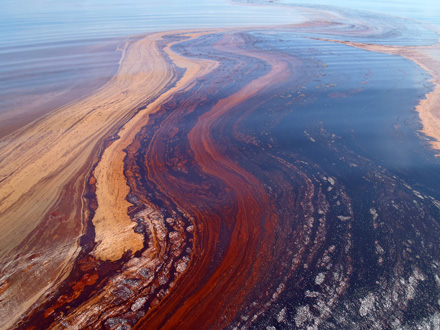 |
| Scientists studied the interaction of the oil spill and microbes in Gulf of Mexico waters. Photograph by Luke McKay, University of Georgia |
The Deepwater Horizon oil spill was unique, according to Valentine and Redmond, because it happened at such great depth and contained so much natural gas, predominantly methane, ethane and propane.
Those factors influenced the way bacteria responded to the spill.
In earlier studies, Valentine, Redmond and colleagues showed that ethane and propane were the major hydrocarbon compounds consumed in June 2010, two months after the April spill.
By September 2010, the researchers discovered that these gases and all the methane had been consumed.
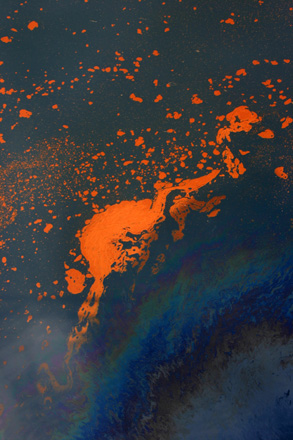 |
| An oil slick at the sea's surface contains orange-colored 'older' oil and a fresher oil sheen. Photograph by David Valentine |
In May and June of 2010, the scientists found that bacterial communities in the submerged plume were dominated by just a few types, Oceanospirillales, Colwellia and Cycloclasticus, and were very different from control samples without large concentrations of oil or gas.
The bacteria were also very different from the microbial communities in surface oil slicks collected at the same time.
"It's much warmer at the surface than in the deep water, around 80 degrees Fahrenheit (F) versus 40 F, which is pretty close to the temperature in your refrigerator," said Redmond, the PNAS paper's lead author.
"There was very little natural gas in the surface samples, suggesting that both temperature and natural gas could be important in determining which bacteria bloomed after the spill," she said.
The bacteria she and Valentine saw in the deep-water samples in May and June were related to types of psychrophilic, or cold-loving bacteria.
"Most bacteria grow more slowly at cooler temperatures -- that's why we keep our food in the refrigerator," said Redmond. "But psychrophilic bacteria actually grow faster at cold temperatures than they would at room temperature."
To provide additional evidence of the importance of temperature, the scientists added oil to water from the Gulf, and incubated it at 40 F and at room temperature (about 70 F). They looked at which bacteria grew at the different temperatures.
In the 40 F samples, Colwellia were most abundant, but were only found in low numbers in the room temperature samples, suggesting that the bacteria have an advantage in cold water.
"To figure out which bacteria were consuming methane, ethane, and propane, we used a technique called stable isotope probing, in which we incubated fresh seawater samples from the Gulf with isotopically labeled methane, ethane, or propane," Redmond said.
The bacteria that grew as they consumed the methane, ethane or propane converted the labeled gases into biomass, including their DNA. By sequencing the DNA, the scientists were able to identify the bacteria.
The bacteria that consumed the ethane and propane were the same Colwellia in the samples from May and June, when ethane and propane consumption rates were high. They were abundant when the researchers incubated oil at 40 F, but not at room temperature.
This suggests, say Valentine and Redmond, that the Colwellia grow well at low temperatures, and can consume ethane and propane.
"The ability of oil-eating bacteria to grow with natural gas as their 'foodstuff' is important," said Valentine, "because these bacteria may have reached high numbers by eating the more-abundant gas, then turned their attention to other components of the oil.
"We've uncovered some of the relationships between hydrocarbons released from Deepwater Horizon and the bacteria that responded," he said.
But questions remain about how the bacteria interacted with one another, and how this affected the fate of the oil.
"This work continues to remind us that the ocean, its microbes, and petroleum hydrocarbons share an ecological history that extends far into the geological past," said Don Rice, director of NSF's chemical oceanography program, which funded the research.
"Our ability to respond to marine oil spills is enormously advanced by this kind of basic research."
This news is from National Science Foundation (NSF) 3 October 2011.
Note:
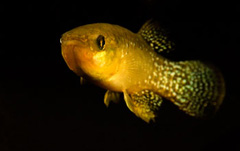 |
| Killifish: the fish studied in the Gulf of Mexico oil spill research project. Photograph by Andrew Whitehead |
A related article is on Horizon International’s oceans and coral reefs website, Magic Porthole, at www.coralreefs.co and www.magicporthole.org:
Gulf of Mexico Deepwater Horizon Spill Effects on Fish Revealed: Oil spill resulted in dramatic effects on fish species in Louisiana marshes
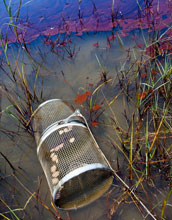 |
| Louisiana's Grand Terre Island marshes contaminated with oil; here, with a minnow trap. Photograph by Andrew Whitehead |
Excerpt: “Despite low concentrations of oil constituents in Gulf of Mexico waters from the Deepwater Horizon spill, fish were dramatically affected by toxic components of the oil. So found a team led by scientists Fernando Galvez and Andrew Whitehead of Louisiana State University (LSU). The researchers published their results this week in the journal Proceedings of the National Academy of Sciences (PNAS).”
Search
Latest articles
Agriculture
- World Water Week: Healthy ecosystems essential to human health: from coronavirus to malnutrition Online session Wednesday 24 August 17:00-18:20
- World Water Week: Healthy ecosystems essential to human health: from coronavirus to malnutrition Online session Wednesday 24 August 17:00-18:20
Air Pollution
- "Water and Sanitation-Related Diseases and the Changing Environment: Challenges, Interventions, and Preventive Measures" Volume 2 Is Now Available
- Global Innovation Exchange Co-Created by Horizon International, USAID, Bill and Melinda Gates Foundation and Others
Biodiversity
- World Water Week: Healthy ecosystems essential to human health: from coronavirus to malnutrition Online session Wednesday 24 August 17:00-18:20
- Mangrove Action Project Collaborates to Restore and Preserve Mangrove Ecosystems
Desertification
- World Water Week: Healthy ecosystems essential to human health: from coronavirus to malnutrition Online session Wednesday 24 August 17:00-18:20
- UN Food Systems Summit Receives Over 1,200 Ideas to Help Meet Sustainable Development Goals
Endangered Species
- Mangrove Action Project Collaborates to Restore and Preserve Mangrove Ecosystems
- Coral Research in Palau offers a “Glimmer of Hope”
Energy
- Global Innovation Exchange Co-Created by Horizon International, USAID, Bill and Melinda Gates Foundation and Others
- Wildlife Preservation in Southeast Nova Scotia
Exhibits
- Global Innovation Exchange Co-Created by Horizon International, USAID, Bill and Melinda Gates Foundation and Others
- Coral Reefs
Forests
- NASA Satellites Reveal Major Shifts in Global Freshwater Updated June 2020
- Global Innovation Exchange Co-Created by Horizon International, USAID, Bill and Melinda Gates Foundation and Others
Global Climate Change
- World Water Week: Healthy ecosystems essential to human health: from coronavirus to malnutrition Online session Wednesday 24 August 17:00-18:20
- Mangrove Action Project Collaborates to Restore and Preserve Mangrove Ecosystems
Global Health
- World Water Week: Healthy ecosystems essential to human health: from coronavirus to malnutrition Online session Wednesday 24 August 17:00-18:20
- More than 400 schoolgirls, family and teachers rescued from Afghanistan by small coalition
Industry
- "Water and Sanitation-Related Diseases and the Changing Environment: Challenges, Interventions, and Preventive Measures" Volume 2 Is Now Available
- Global Innovation Exchange Co-Created by Horizon International, USAID, Bill and Melinda Gates Foundation and Others
Natural Disaster Relief
- STOP ATTACKS ON HEALTH CARE IN UKRAINE
- Global Innovation Exchange Co-Created by Horizon International, USAID, Bill and Melinda Gates Foundation and Others
News and Special Reports
- World Water Week: Healthy ecosystems essential to human health: from coronavirus to malnutrition Online session Wednesday 24 August 17:00-18:20
- STOP ATTACKS ON HEALTH CARE IN UKRAINE
Oceans, Coral Reefs
- World Water Week: Healthy ecosystems essential to human health: from coronavirus to malnutrition Online session Wednesday 24 August 17:00-18:20
- Mangrove Action Project Collaborates to Restore and Preserve Mangrove Ecosystems
Pollution
- Zakaria Ouedraogo of Burkina Faso Produces Film “Nzoue Fiyen: Water Not Drinkable”
- "Water and Sanitation-Related Diseases and the Changing Environment: Challenges, Interventions, and Preventive Measures" Volume 2 Is Now Available
Population
- "Water and Sanitation-Related Diseases and the Changing Environment: Challenges, Interventions, and Preventive Measures" Volume 2 Is Now Available
- "Water and Sanitation-Related Diseases and the Changing Environment: Challenges, Interventions, and Preventive Measures" Volume 2 Is Now Available
Public Health
- World Water Week: Healthy ecosystems essential to human health: from coronavirus to malnutrition Online session Wednesday 24 August 17:00-18:20
- STOP ATTACKS ON HEALTH CARE IN UKRAINE
Rivers
- World Water Week: Healthy ecosystems essential to human health: from coronavirus to malnutrition Online session Wednesday 24 August 17:00-18:20
- Mangrove Action Project Collaborates to Restore and Preserve Mangrove Ecosystems
Sanitation
- World Water Week: Healthy ecosystems essential to human health: from coronavirus to malnutrition Online session Wednesday 24 August 17:00-18:20
- Promoting the Development of Rural Water Supply and Sanitation -Case from Zhejiang Province, China
Toxic Chemicals
- "Water and Sanitation-Related Diseases and the Changing Environment: Challenges, Interventions, and Preventive Measures" Volume 2 Is Now Available
- Actions to Prevent Polluted Drinking Water in the United States
Transportation
- "Water and Sanitation-Related Diseases and the Changing Environment: Challenges, Interventions, and Preventive Measures" Volume 2 Is Now Available
- Urbanization Provides Opportunities for Transition to a Green Economy, Says New Report
Waste Management
- Promoting the Development of Rural Water Supply and Sanitation -Case from Zhejiang Province, China
- "Water and Sanitation-Related Diseases and the Changing Environment: Challenges, Interventions, and Preventive Measures" Volume 2 Is Now Available
Water
- World Water Week: Healthy ecosystems essential to human health: from coronavirus to malnutrition Online session Wednesday 24 August 17:00-18:20
- UN Food Systems Summit Receives Over 1,200 Ideas to Help Meet Sustainable Development Goals
Water and Sanitation
- World Water Week: Healthy ecosystems essential to human health: from coronavirus to malnutrition Online session Wednesday 24 August 17:00-18:20
- Mangrove Action Project Collaborates to Restore and Preserve Mangrove Ecosystems

